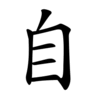自
| ||||||||
| ||||||||
| ||||||||
Translingual
| Stroke order | |||
|---|---|---|---|
| Stroke order | |||
|---|---|---|---|
 | |||
Han character
自 (Kangxi radical 132, 自+0, 6 strokes, cangjie input 竹月山 (HBU), four-corner 26000, composition ⿱丿目)
- Kangxi radical #132, ⾃.
Derived characters
References
- KangXi: page 1000, character 7
- Dai Kanwa Jiten: character 30095
- Dae Jaweon: page 1452, character 1
- Hanyu Da Zidian (first edition): volume 5, page 3046, character 1
- Unihan data for U+81EA
Chinese
| simp. and trad. |
自 | |
|---|---|---|
Glyph origin
| Historical forms of the character 自 | |||||
|---|---|---|---|---|---|
| Shang | Western Zhou | Warring States | Shuowen Jiezi (compiled in Han) | Liushutong (compiled in Ming) | |
| Oracle bone script | Bronze inscriptions | Chu slip and silk script | Ancient script | Small seal script | Transcribed ancient scripts |
 |
 |
 |
 |
 |
 |
Characters in the same phonetic series (自) (Zhengzhang, 2003)
Originally a pictogram (象形) of a nose; in China (and East Asia) one points at one’s nose to indicate oneself, hence an ideogram (指事) of “self”.
The original meaning of “nose” has been replaced by 鼻.
Pronunciation
Definitions
自
Compounds
Derived terms from 自
|
|
|
Japanese
Readings
Compounds
Compounds
- 自慰 (jii)
- 自演 (jien): starring in a movie or play one is also directing
- 自我 (jiga)
- 自画 (jiga): self-portrait
- 自戒 (jikai): self-admonishment
- 自覚 (jikaku)
- 自棄 (jiki)
- 自己 (jiko)
- 自在 (jizai)
- 自作 (jisaku)
- 自殺 (jisatsu): suicide
- 自賛 (jisan): self-praise
- 自主 (jishu)
- 自首 (jishu)
- 自信 (jishin)
- 自身 (jishin)
- 自責 (jiseki)
- 自然 (shizen)
- 自尊 (jison)
- 自体 (jitai)
- 自治 (jichi)
- 自答 (jitō)
- 自動, 自働 (jidō)
- 自分 (jibun)
- 自暴 (jibō): despair
- 自問 (jimon)
- 自由 (jiyū)
- 自力 (jiriki)
- 自立 (jiritsu)
- 自律 (jiritsu)
- 各自 (kakuji)
- 独自 (dokuji)
Korean
Okinawan
Compounds
- 自由 (jiyū)
Vietnamese
This article is issued from Wiktionary. The text is licensed under Creative Commons - Attribution - Sharealike. Additional terms may apply for the media files.